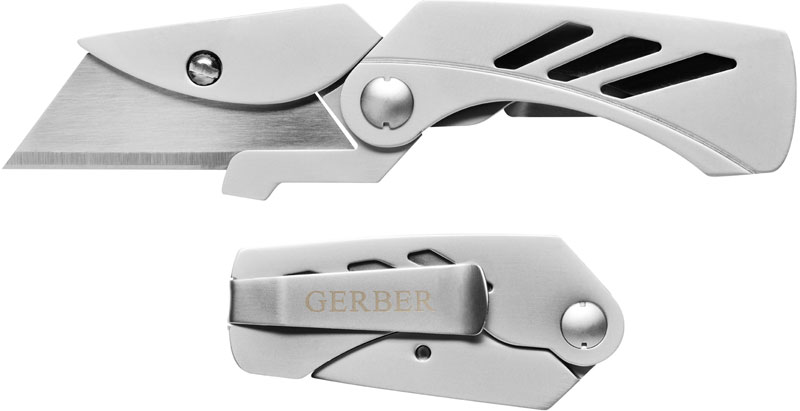When I was 8 years old, and became a Cub Scout, my grandfather gave me my first pocket knife. Since then I’ve carried a knife almost every day of my life (when I was a kid we could have a knife at school). For the last few years I’ve carried a Benchmade 930 Kulgera. I love my knife and I don’t like to use it to cut cardboard (which quickly dulls it), sticky stuff, in the dirt, etc. – I will if I have to, but I’m not happy about it.
I first heard about the Gerber EAB Lite on The Survival Podcast (Episode 611). EAB stands for Exchange A Blade. The Gerber EAB is a folding, lightweight, utility knife that uses a standard size utility blade. It was described as a knife that was so compact and convenient that you could easily carry it–in addition to your normal every day carry knife–and have it available to use for those dirty jobs. Once the blade is dull, change it by either flipping it around or exchange the blade for a new one (like a traditional utility knife).
 I decided to go ahead and buy one – it only cost $12. When I got it home I was very pleased. It’s a nice looking tool, very compact, with a good pocket clip. The blade is kept in place with a set screw so it won’t come loose; to change it you will need to remove the screw (but it can even be done with a dime). It clips and fits nicely in the right side watch pocket of my Carhartt jeans. The folded knife could also double as a money clip; when folded it looks very innocuous – most people would never notice that your money clip is actually a knife.
I decided to go ahead and buy one – it only cost $12. When I got it home I was very pleased. It’s a nice looking tool, very compact, with a good pocket clip. The blade is kept in place with a set screw so it won’t come loose; to change it you will need to remove the screw (but it can even be done with a dime). It clips and fits nicely in the right side watch pocket of my Carhartt jeans. The folded knife could also double as a money clip; when folded it looks very innocuous – most people would never notice that your money clip is actually a knife.
I was so impressed with this knife that I bought three more, one for: Sarah, Ryan, and Chanse. I stocked up on extra blades, 100 utility knife blades costs less than $15; with that you could change the blade of your knife each week for almost two years. Because of the durability of the handle and the razor sharpness of the utility blade, you could easily use it for anything from cutting carpet to skinning small game to minor surgery (it’s sharp enough, but not clean enough). All you do to keep sharp it is change the blade.
I still carry my Benchmade everyday, but now I also carry a second knife: a Gerber EAB Lite. (Repetitive and Redundant)
Stats for the Gerber EAB Lite
- Open Length: 5.1”
- Closed Length: 2.85”
- Weight: 2.5 oz
- Handle Material: Stainless Steel
UPDATE 2/3/12: There has been discussion on TSP Forum where several people complained about the clip easily breaking off the knife. I’ve carried mine, clipped to my pocket everyday, for a couple of months now without any issues. But just to do some follow-up, I contacted Gerber’s Warranty Department (by email). I told them we have several EABs and expressed my concern about the clip weakness, and asked them for a couple extra clips to keep on hand. They, no questions or hassles, sent me three replacement clips – no charge for shipping or anything. In summary, it’s a good little knife, good customer service experience, and I haven’t had any issues with the clip.
UPDATE 3/16/12: Finally, as everyone told me it would, the clip broke off. I had only carried it clipped to my pocket, every day, for about three months when it did. Fortunately, you say, I had extras on hand right? Sort of, they don’t go on well and two broke trying to get them on – before I gave up. Ironically, as I keep mine in the watch/change pocket of my jeans, it works just fine and actually now has a slimmer profile. If I ever buy a replacement one, I’ll just remove the clip. Final clip recommendation: Don’t plan on keeping it clipped to a pocket – the clip will break. The clip would work fine as a money clip (maybe that’s all the designers had in mind). But clip or not, it’s a handy, small, folding EDC utility knife that still has all of the benefits previously discussed. I love mine, carry it everyday, and would encourage anyone else to do the same.
(Disclaimer: I have no association with this product or any dealer or manufacturer. I researched and bought the product to add to my preps and I wanted to pass along the experience I have had with it.)
(Wednesday: My wife, Sarah, guest posts and answers the question she frequently hears, ‘What Do You Think About All This?‘)





















